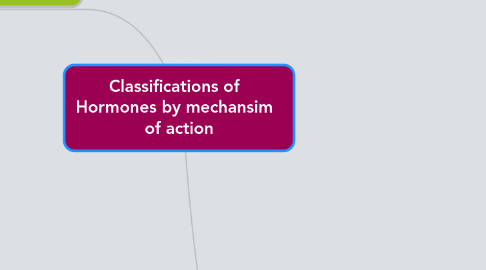
1. Bind to intracellular receptors "steroid-Thyroid superfamily".
1.1. Steroid Hormones
1.1.1. Mineralocorticoids
1.1.2. Sex hormones
1.1.2.1. Male sex hormone
1.1.2.1.1. androgens
1.1.2.2. Female sex hormones
1.1.2.2.1. Estrogens & Progestins
1.1.3. Glucocorticoids
1.2. Thyroid Hormones "T3 & T4"
1.3. Calcitriol (vit D)
1.3.1. Active form of vit D
1.4. Retinonic acids (vit A)
1.5. Receptor- Hormon complex which act in the DNA either in Enhancer region: increase gene expression or Silencer region: decrease gene expression
2. Bind to cell surface receptor "2nd messenger"
2.1. cAMP
2.1.1. Catacholamines (alpha-2 & B adrenergi)
2.1.2. Anterier pituitary hormones
2.1.2.1. ACTH, FSH, LH &TSH except: GH & prolactin !!
2.1.3. ADH (renal V2- receptor)
2.1.4. Calcitonin & PTH
2.1.5. Glugogon
2.2. cGMP
2.2.1. Atrail natriuretic peptide (ANP)
2.2.2. Nitric Oxide (NO)
2.3. Calcium or phosphatidylinositol (or both)
2.3.1. Ach (Muscrinic)
2.3.2. Catacholamines (alpha-1 adrenergic)
2.3.3. Angitonesin II
2.3.4. ADH (vasopressin): extrarenal V-1 receptors
2.3.4.1. V-1 on blood vessels ( extra renal)
2.3.5. phosphatidylinositol is broken by phospholipase C which give- DAG & IP3=> which both eventually activate Protein kinase C(IP3 activate protein kinase C Indirectly by releasing Ca++ from the ednoplasmic reticulum) #mnemonic: - alpha-1 & V1 - both Ang II & vassopressin on V1 => vasoconstrictors!
2.4. Tyrosin kinase cascade
2.4.1. GH & prolactin
2.4.1.1. also GH & prolactin has other relation that they are both acidophilic cells in anterior pituitary gland (pars distalis)
2.4.2. insulin
2.4.3. Erythropoietin

